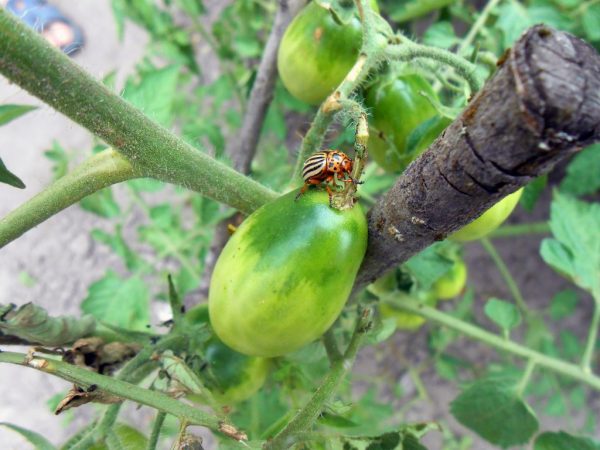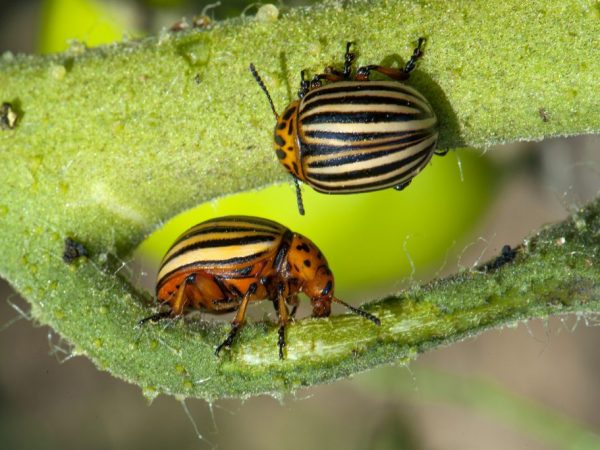How to deal with the Colorado potato beetle on tomatoes
For a rich harvest of tomatoes, the growing conditions must be observed: watering regularly, feeding and preventive measures. Tomatoes are susceptible to attack by various pests, including the Colorado potato beetle. If you do not take measures to combat this insect in time, you can lose your crop. Consider what to do when the Colorado potato beetle appears on tomatoes.

Fighting Colorado Potato Beetle on Tomatoes
History of origin
The Colorado potato beetle was first discovered and recorded in Mexico. After a while, he crossed the Atlantic with transported goods and in the 40s of the last century reached the borders of the USSR, where he became the main pest of the potato crop. However, his attention was focused not only on potato leaves: the Colorado potato beetle on tomatoes is not uncommon. With no less pleasure, the insect absorbs all nightshade crops: leaves of pepper, eggplant, melon pear, tobacco.
Tatiana Orlova (Candidate of Agricultural Sciences):
Potatoes are the most popular food plant for the Colorado potato beetle. The beetle damages not only the aerial part of the plant, but also the tubers. This beetle passes to feed on other plants in the absence of its natural food base, for example, after harvesting early potatoes.
The difficulty is that this beetle has no natural enemies in our fauna - its population is uncontrollable. He hibernates easily, burrowing in the ground, and wakes up in the spring to destroy young shoots and leaves.
Protection methods
Gardeners who do not want to treat tomatoes with chemicals collect insects by hand, which is a laborious and time-consuming process.
It is possible to protect plantings from beetles in other ways that save time and do not involve the use of active chemicals. You can fight pests using:
- A remedy based on the insects themselves. This poison is made from adult beetles, which are collected in a liter container to the bottom. Then they are poured into a standard bucket and filled with water. After the dead beetles settle to the bottom, the liquid is infused for a week. After that, the poison can be considered ready. This solution is not recommended to be used without diluting with water in a ratio of 1: 1 or 1: 2, as there is a possibility of burning the culture. The processed tomatoes are monitored for a couple of days to determine the effectiveness of a particular concentration of the prepared agent;
- Ashes. This substance is not only a natural fertilizer, but also a proven pest control agent. It can be applied as follows:
- In the process of planting tomato seedlings, mix and pour ash made from birch wood and earth into the recess for seedlings.
- On flowering process tomatoes with ash, using a sieve or sieve in a proportion of 1 kg of ash per 10 square meters. m of planting material. It is best to do this when there is dew on the plants or immediately after rain. Repeat the procedure 4 times a season, twice a month.
- Spray the culture with an extract of ash and wormwood.Mix a glass of wood ash with fresh wormwood leaves (250 g), pour heated water into the mixture and let it brew for a couple of hours. Strain the solution. There is also the following option: finely chop half a kilogram of wormwood and mix with a glass of ash and 1 tbsp. l. liquid soap. Pour 10 liters of hot water, stir, then leave for about 5 hours. The resulting product can be sprayed on tomato plants.
Biological control methods

The beetle can be fought with the help of insects
Biological techniques for protecting plants from pests include countering birds and other insects.
- Dry grass mulching. One of the simplest ways to stop the beetle from growing on tomatoes is to spread straw mulch in the middle of the beds. This helps to create an optimal environment for the life of predatory insects, which can be potential enemies of the Colorado potato beetle, and helps to protect plants from it. Among these predators are ladybugs, grasshoppers, dragonflies, praying mantises, lacewing, garden ground beetles. This method not only makes it possible to avoid the appearance of a large number of pests, but also inhibits the growth of weeds, helps moisture to stay in the soil.
- One of the options for preventing the appearance of beetles on tomatoes is to accustom some species of birds to feed on these insects. Such birds can be starlings, tits, swifts, swallows, finches and some others. To attract these birds, birdhouses are hung around the site. Of domestic birds, chickens help in the fight against insects. It is advisable to teach them from childhood. This can be done by adding half of the insect to their regular food, increasing the amount every week.
Tatiana Orlova (Candidate of Agricultural Sciences):
Why don't birds use Colorado potato beetle larvae for food? The fact is that the beetle feeds on plants of the Solanaceae family, which contain the poisonous glycoside solanine in the leaves and stems. Plus, it tastes bitter. The larvae will be just as bitter for the birds, and if they begin to use them in large quantities, they can be poisoned.
You can get rid of the Colorado potato beetle on tomatoes by applying chicken droppings. It is brought in after the harvest has been harvested. The entire area of the site is treated with a 5% solution of chicken manure. For this, about 80 buckets are taken for one hundred square meters.
Tatiana Orlova (Candidate of Agricultural Sciences):
However, the mechanical and biological methods of controlling the Colorado potato beetle, frankly, are not very effective. The most effective protective method is still chemical. It is not necessary to constantly spray your plantings with chemicals. You can make only one treatment, but do it in the most vulnerable phase of the beetle's life. Adult beetles are covered with a chitinous "shell" like armor. It is quite difficult to deal with them. But the red beetle larvae are inactive and vulnerable to impact. The treatment is carried out against them and the best chemical preparations today are Regent, Prestige, Tabu, Aktara.
Conclusion
Now you know how to protect tomatoes from Colorado potato beetles. It is enough not to forget to carry out preventive measures in order to prevent the appearance of such pests, and in case of their appearance, immediately begin the fight. Only if you fight insects can you get a healthy crop and a rich harvest.



